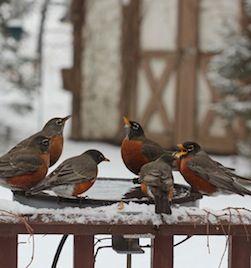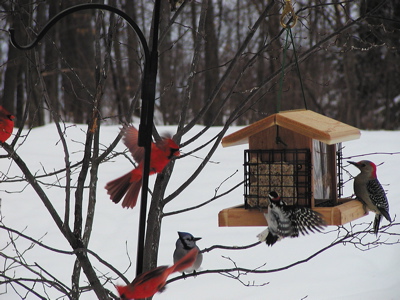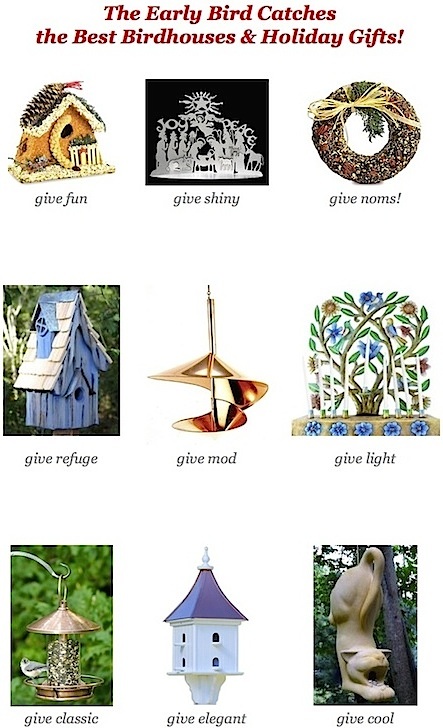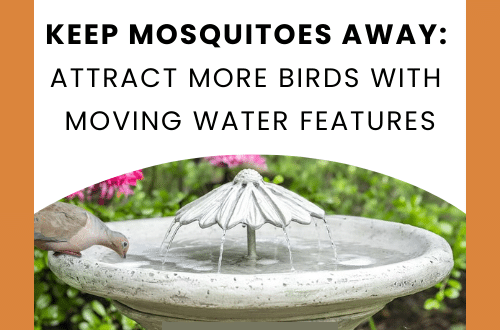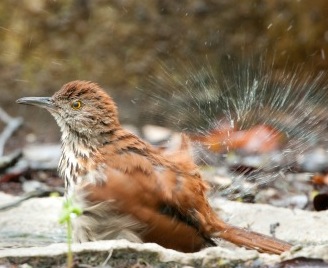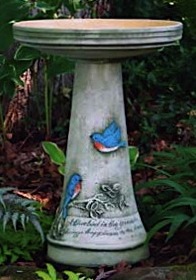-
Give Thanks-Give Warmth- Heated Bird Baths Rule!
Warm & Happy Thanksgiving Wishes!
Gift idea # 30: Give warmth
Okay, we skipped a few days getting ready for the holidaze! It can be a crazy, stressful time, running and doing, and going, and fulfilling obligations. With Thanksgiving upon us, it’s a great time to chill with friends, with family, with nature. Look around and breathe, what are you thankful for?
As corny as it sounds, and aside from the usual answer of friends and family, we’re thankful for the habitat in our yard, the characters it hosts, and how it’s grown over the years… simply because it offers an escape from the everyday chaos of life. We’re really thankful for our awesome customers, especially the ones who return again and again! I doubt companies selling electronics are lucky enough to get the same breed of folks, those who are so appreciative of nature.
Whenever there’s an opportunity to sit, be still and just watch the birds, or a butterfly around lantana – there’s a calming effect that’s pretty indescribable. Sometimes ya just have to wonder… am I getting old? Well, with age comes wisdom (hopefully) so receiving joy from something as simple as nature can be a blessing in itself. Sadly, many are blind to it these days.
During frigid winter months, the best hot spot for watching feathered friends has got be heated bird baths (no pun intended). More so than any kind of feeders or birdhouses, fresh water attracts more species and greater numbers for ultimate viewing from your home.
Can’t they just eat snow? Sure, birds do have the capacity to convert the fluff to liquid, but it costs them precious calories in the process. Since calories equal energy, it’s a resource that can cost overnight heat loss. Some birds will feed from sun-up through late afternoon, continuous eating just to consume enough calories for the next freezing night. Essentially, those calories are wasted when digesting snow for water. So offer up a heated bath to help resident birds thrive and bring some new visitors to your place! No need for a whole new set-up, just add a heater, most are safe for all birdbath types these days!
And because Thanksgiving is here, we say Let Giving Take Flight to start the holiday season! For useful and creatively fun ideas for any nature-lover on your list, we’ll offer suggestions to dazzle them and their feathered friends alike! And what would make us an authority? Backyard birding freaks for 30 years 🙂
-
Adding Heated Bird Baths is the Trick for Winter
This question appeared in our in box today. We thought the response might be useful to others who cant seem to attract nesting birds.
“Do you have an idea how I can get the birds to use my bird houses? I have a small yard and only one tree that I can put the bird house in, that the cats can’t get to them. ( Can I put more than one in the tree and hope they will use them. ( I would like them to be used and as well as looks) But they don’t seem to use it. Last year one pair of birds (chickadees I think) did use the house and I was so excited and loved watching them make their nest and feed the young, I thought they would come again this year, but they didn’t. I cleaned the house and actually only saw a chickadee one time this year ( I assumed it was the one that came last year) the bird love for me to feed them and they drink the hummingbird nectar. I even bought a cotton nesting ball, but have not seen any birds even use it. Any ideas will be a great help. I don’t know why the chickadee is not coming around this year.”
Thanks for visiting!
Although they say not to crowd houses together, chickadees will usually nest in hanging houses that are in close proximity to each other… mine seem to anyway! Not sure how large the tree is, but maybe one nest box on each side would do the trick?
Nesting season is through for this year, but your chickadees (or other birds) may use the house for roosting on cold nights.
Not much success with my cotton nesting ball either, I think they’re woven too tightly!
A better mix is using decorative mosses (Spanish and sphagnum sheet moss) feathers, and pet hair if you have access.
You can pick apart the nest ball as well and add this material to the mix.Put these in a standard suet cage, or mesh produce bag from the grocery store. Don’t pack too tightly, so that air can flow through and allow for drying after rain. Hang from a branch where birds will see it. Early spring is the best time to offer the materials… before nesting begins.
You can try adding some dried grass clippings to your house, in hopes of enticing chickadees to roost.
They will hang around for the winter, especially if you’re feeding them.
Offering fresh water is the absolute best way to keep birds around, even if it’s just a plant saucer… keep the water fresh and they will come!Not sure where you’re located, but heated bird baths in winter are truly a God-send for birds!
They need to bathe in order for feathers to work properly!Also, if the cats are outdoors, they may be inhibiting chickadees’ desire to nest, simply because they’re uncomfortable seeing the cats in the yard.
I’ve found over the years, persistence is the key with attracting wild birds! After years of trying, I finally have bluebirds who nest every year 🙂Hope this helps… I think there’s a new blog post here!
Thanks again & happy birding!
Take good care,
Beth -
Turnovers are for apples… not bird baths
One fairly common sight during winter in colder locales (which most folks probably don’t even notice) is the unused, out of commission, over-turned bird bath. The scene is saddening. Obviously folks do this to keep them from freezing and cracking, but this is actually when birds need water most! Sure they can eat snow, (not ice though) but it takes their tiny bodies lots of energy to convert that snow to water. Calories=Energy=Warmth.
When temperatures freeze, shallow pools and puddles are the first thing to ice over, and many feathered friends may have become accustomed and dependent on these water sources. Not only for drinking, but bathing in winter is critical too! Feathers must be clean and oiled to work properly, for flying sure, but for insulation as well. Clean feathers are able to trap air pockets which help keep birds warm in frigid weather. It’s one of the innate, ingenious mechanisms they use to survive. You know… when you see them all puffed up and round looking, that’s air pockets between their feathers.
Offering a fresh water source (especially in winter) is an absolute, sure-fire way to keep birds around your place. It’s part of the reason our bluebirds brave cold winters here in the North Georgia mountains. Heated bird baths are an investment in your wildlife habitat. Just unplug for use year round and it’s likely one of the best investments in backyard birding. If a heated bath isn’t within budget, opt for a simple heater you can add to your existing bath… or even a shallow pan of water. Deeper plant saucers make great bird baths, and many of the heaters today are safe with resin and plastics. If your container is more than 2-3 inches deep, consider placing a large rock in the center for birds to land and perch safely.
Here’s one of our own baths turned heated bath for winter. It’s actually a poly-resin planter that
looks like rock. It sits on a tree stump and blends nicely with the landscape. Birds love it because it’s shaded in summer, and offers somewhat of an escape from predators in the surrounding tree. They also like it because the water stays clean… that’s important! If you’re going to offer a water source, be sure to maintain it by keeping water fresh.
Help resident birds in your neck of the woods with heated bird baths this winter… betcha they stick around through spring and summer too!

